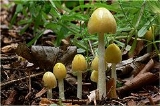
Bolbitiaceae
Encyclopedia
The Bolbitiaceae are a family
of basidiomycete fungi. There are 17 genera
and 171 species in the family.
on gills, brown spore
s and a hymenoderm pileipellis
.
are mushrooms which are thin, Mycena-like, with gelatinous pileus (mycology)cap surface. These lack a veil
, are saprotrophic, and tend to be found with grass.
Conocybe
are mushrooms which are thin, Mycena-like, with a dry cap surface. These are small and saprotrophic, and tend to be found with grass. These have cheilocystidia which are capitate.
Pholiotina
are mushrooms which are thin, Mycena-like, with a dry cap surface. These are small and saprotrophic, and tend to be found with grass, and have a veil. Some have a membranous veil, mid-stipe
,
others the veil breaks up and can be found on the cap margin. These are separated from Conocybe
in that the cheilocystidia are non-capitate.
Family (biology)
In biological classification, family is* a taxonomic rank. Other well-known ranks are life, domain, kingdom, phylum, class, order, genus, and species, with family fitting between order and genus. As for the other well-known ranks, there is the option of an immediately lower rank, indicated by the...
of basidiomycete fungi. There are 17 genera
Genera
Genera is a commercial operating system and development environment for Lisp machines developed by Symbolics. It is essentially a fork of an earlier operating system originating on the MIT AI Lab's Lisp machines which Symbolics had used in common with LMI and Texas Instruments...
and 171 species in the family.
Description
This family is of mushrooms that have a hymeniumHymenium
The hymenium is the tissue layer on the hymenophore of a fungal fruiting body where the cells develop into basidia or asci, which produce spores. In some species all of the cells of the hymenium develop into basidia or asci, while in others some cells develop into sterile cells called cystidia or...
on gills, brown spore
Spore
In biology, a spore is a reproductive structure that is adapted for dispersal and surviving for extended periods of time in unfavorable conditions. Spores form part of the life cycles of many bacteria, plants, algae, fungi and some protozoa. According to scientist Dr...
s and a hymenoderm pileipellis
Pileipellis
thumb|300px||right|The cuticle of some mushrooms, such as [[Russula mustelina]] shown here, can be peeled from the cap, and may be useful as an identification feature....
.
Differences in genera
BolbitiusBolbitius
Bolbitius is a genus of small mushrooms in the Bolbitiaceae family.- Taxonomic details :The genus Bolbitius is defined as small thin Mycena-like mushrooms, with an hymenoderm pileipellis, a glutinous cap surface, and spores which are brown in deposit...
are mushrooms which are thin, Mycena-like, with gelatinous pileus (mycology)cap surface. These lack a veil
Partial veil
thumb|150px|right|Developmental stages of [[Agaricus campestris]] showing the role and evolution of a partial veilPartial veil is a mycological term used to describe a temporary structure of tissue found on the fruiting bodies of some basidiomycete fungi, typically agarics...
, are saprotrophic, and tend to be found with grass.
Conocybe
Conocybe
The genus Conocybe is a genus of mushrooms consisting of Conocybe tenera and at least 243 other species, with at least 50 species in North America....
are mushrooms which are thin, Mycena-like, with a dry cap surface. These are small and saprotrophic, and tend to be found with grass. These have cheilocystidia which are capitate.
Pholiotina
Pholiotina
Pholiotina is a genus of small mushrooms.-Taxonomic details:The genus Pholiotina is defined as small thin Mycena like mushrooms,with an hymenoderm pileipellis, a dry cap surface, cystidia which are...
are mushrooms which are thin, Mycena-like, with a dry cap surface. These are small and saprotrophic, and tend to be found with grass, and have a veil. Some have a membranous veil, mid-stipe
Stipe (mycology)
thumb|150px|right|Diagram of a [[basidiomycete]] stipe with an [[annulus |annulus]] and [[volva |volva]]In mycology a stipe refers to the stem or stalk-like feature supporting the cap of a mushroom. Like all tissues of the mushroom other than the hymenium, the stipe is composed of sterile hyphal...
,
others the veil breaks up and can be found on the cap margin. These are separated from Conocybe
Conocybe
The genus Conocybe is a genus of mushrooms consisting of Conocybe tenera and at least 243 other species, with at least 50 species in North America....
in that the cheilocystidia are non-capitate.

